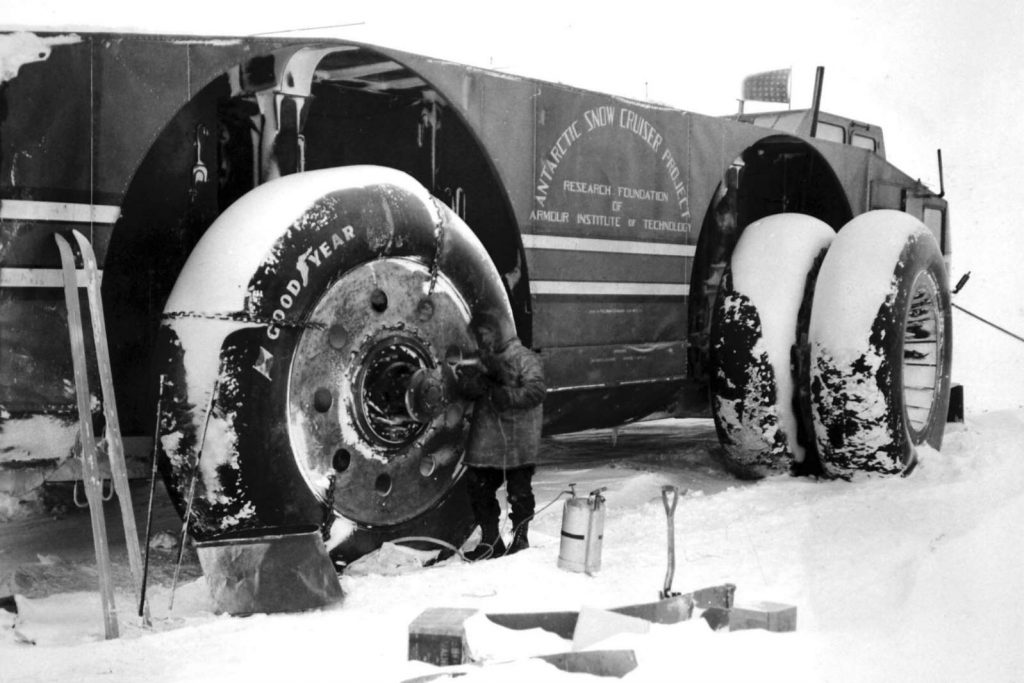R.G. LeTourneau’s Overland Trains were not the first large rubber tires to navigate the extreme snow and ice. When Dr. Thomas C. Poulter received notification that Admiral William Byrd was planning an another scientific expedition to the Antarctic at the end of 1939, he secured $150,000 in funding to build the Snow Cruiser. Dr. Poulter designed the Snow Cruiser after he nearly died in a previous expedition with Admiral Byrd (1933-1935). Dr. Poulter imagined that research should be mobile; expeditions would be much safer and more effective than tent based stations. Construction on the Snow Cruiser began in Chicago, August of 1939. The Snow Cruiser was completed in 11 weeks. For comparison, the Sno-Freighter was built in 6 weeks. In 1939, the Byrd-Poulter Snow Cruiser landed in Antarctica.
Dr. Poulter designed the Snow Cruiser to float atop the snow and ice terrain. Similar to a few of the Overland Trains and Buggies, it had large tires, 10 foot in diameter, and two diesel engines that drove electrics generators for 4 independent electric wheels. It had a top speed of 30 miles per hour and could traverse a 35% grade.
The Snow Cruiser’s lack of terrain crossing became evident immediately after landing in Antarctica. The machine was tested in the sand, but never in the snow or ice. The construction rush never lended itself to increased testing. The slick Good Year tires spun on the snow and ice. The video below shows the Snow Cruiser being dug out of the mud after in drove into a muddy creek.
The machine never made it more than 92 miles a day. Researchers on board found out that the machine had more traction and power in reverse. They attempted to take the two spare tires and attach them to the front for driving operations in reverse. The LeTourneau Sno-Buggy would test the same dual tire configuration in Greenland 13 years later in 1954. Except, this time, they would drive forward! After a bit of tough goings, the Snow Cruiser was parked, marked with wooden stakes, and used as a stationary research camp until 1941. It was left to the elements not to be seen again until 1958, where it was briefly rediscovered only to get lost to the elements once again.

In 1963, the United States Navy icebreaker U.S.S. Edisto captured the photograph below of Little Miss America III, Byrd’s research station. You can still see the bamboo poles atop the ice in the top left of the image where is was marked in 1941. In 2005, two researchers, Ted Scambos and Clarence Novak, published a paper theorizing where the Snow Cruiser could be located (https://doi.org/10.1080/789610142). The iceberg containing Little Miss America III and the Snow Cruiser is now approximately 18km from the coast. The researchers in the 2005 paper did not have an exact location, but came to the conclusion that the Snow Cruiser sits on the ocean floor or on the land bound side of the ice. There is also some speculation that the Russians may have picked it up off of the sea floor years ago.

Tires
One of the base design problems with Dr. Poulter’s Snow Cruiser were the bald balloon tires. In 1939, tire manufacturers and the heavy equipment industry were just getting started using balloon tires. They didn’t have any traction components or tread as of yet. The tire molds that Good Year used for the Snow Cruiser tires were the same used on the Gulf Marsh Buggy. The Gulf Marsh Buggy was highly mobile in the snow and ice. The difference is that the tire loadings on the Snow Cruiser versus the Gulf Marsh Buggy differ by a factor of 5. The Gulf Marsh Buggy loading was approximately 3,500 pounds per wheel. The loading on the Snow Cruiser was approximately 17,500 pounds per wheel. Later analysis would show that a loading of around 6,000-10,000 pounds would be functional on the ice and snow.
Dr. Poulter Visits the LeTourneau Factory
In October of 1954, Dr. Poulter visited the LeTourneau, Inc. factory in Longview, TX. In the image below, Dr. Poulter (left) is seen with R.L. LeTourneau as they inspect the VC-12 Tournatrain. Dr. Poulter stopped in at the factory, en-route to Ft. Eustis, where he was to serve as a consultant to the USAR Transportation Research and Development Command (TRADCOM).

In a different meeting, Dr. Poulter was on hand to view testing for the Sno-Buggy. He spent the day on October 14, 1954, testing the Tournatrain. Dr. Poulter was especially enthusiastic about the electric drive system used in the LeTourneau machine. The Snow Cruiser used a similar electric drive system during the 1939 expedition.
Further Reading








